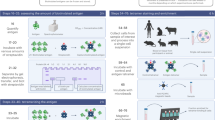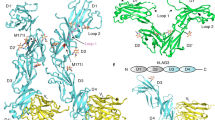Abstract
The mouse genome possesses five genes encoding proteins homologous to human Leu-13. The Leu-13 protein associates with immune cell receptor activation complexes: a monoclonal antibody against Leu-13 induces T and B cells to form homotypic aggregates, inhibits activation-induced proliferation and induces the shedding of L-selectin. The mouse fragilis proteins have not been previously analyzed as components of the immune response. Antibody and nucleic acid reagents were generated that are specific for each of the five fragilis gene products. Expression of some of these genes (fragilis and fragilis3) is wide spread in a variety of mouse immune (and nonimmune) tissues while others (fragilis5) appear to be much more restricted. These proteins have been predicted to span the membrane twice with both amino- and carboxyl-terminal sequences extracellular: we show that a highly conserved loop of the protein between the transmembrane domains is intracellular. The fragilis proteins are associated with tetraspanin proteins CD81 and CD9: B cell activation positions fragilis into lipid rafts along with the CD81, CD19, and CD21. The mouse functional equivalent to human Leu-13 may not be single gene product, but instead may require the contribution of multiple fragilis proteins.
This is a preview of subscription content, access via your institution
Access options
Subscribe to this journal
Receive 6 digital issues and online access to articles
$119.00 per year
only $19.83 per issue
Buy this article
- Purchase on Springer Link
- Instant access to full article PDF
Prices may be subject to local taxes which are calculated during checkout









Similar content being viewed by others
References
Lange UC, Saitou M, Western PS, Barton SC, Surani MA . The fragilis interferon-inducible gene family of transmembrane proteins is associated with germ cell specification in mice. BMC Dev Biol 2003; 3: 1.
Martensen PM, Justesen J . Small ISGs coming forward. J Interferon Cytokine Res 2004; 24: 1–19.
Deblandre GA, Marinx OP, Evans SS, Majjaj S, Leo O, Caput D et al. Expression cloning of an interferon-inducible 17-kDa membrane protein implicated in the control of cell growth. J Biol Chem 1995; 270: 23860–23866.
Evans SS, Lee DB, Han T, Tomasi TB, Evans RL . Monoclonal antibody to the interferon-inducible protein Leu-13 triggers aggregation and inhibits proliferation of leukemic B cells. Blood 1990; 76: 2583–2593.
Zucchi I, Montagna C, Susani L, Vezzoni P, Dulbecco R . The rat gene homologous to the human gene 9-27 is involved in the development of the mammary gland. Proc Natl Acad Sci USA 1998; 95: 1079–1084.
Pru JK, Austin KJ, Haas AL, Hansen TR . Pregnancy and interferon-tau upregulate gene expression of members of the 1-8 family in the bovine uterus. Biol Reprod 2001; 65: 1471–1480.
Pru JK, Austin KJ, Perry DJ, Nighswonger AM, Hansen TR . Production, purification, and carboxy-terminal sequencing of bioactive recombinant bovine interferon-stimulated gene product 17. Biol Reprod 2000; 63: 619–628.
Morel N, Brochier G, Synguelakis M, Le Gal La Salle G . Immunological identification of a new 14X10(3) Mr membrane-bound protein in Torpedo electric organ. J Cell Sci 1991; 98 (Part 3): 351–361.
Chen YX, Welte K, Gebhard DH, Evans RL . Induction of T cell aggregation by antibody to a 16kd human leukocyte surface antigen. J Immunol 1984; 133: 2496–2501.
Kansas GS, Tedder TF . Transmembrane signals generated through MHC class II, CD19, CD20, CD39, and CD40 antigens induce LFA-1-dependent and independent adhesion in human B cells through a tyrosine kinase-dependent pathway. J Immunol 1991; 147: 4094–4102.
Bradbury LE, Kansas GS, Levy S, Evans RL, Tedder TF . The CD19/CD21 signal transducing complex of human B lymphocytes includes the target of antiproliferative antibody-1 and Leu-13 molecules. J Immunol 1992; 149: 2841–2850.
Levine S, Xian CY, Agocha B, Allopenna J, Welte K, Armstrong D et al. Differential modulation of the CD-2 and CD-3 T cell activation pathways by a monoclonal antibody to Leu-13. Cell Immunol 1991; 132: 366–376.
Hillman Jr MC, Knight Jr E, Blomstrom DC . A membrane protein from IFN-beta-treated Daudi cells causes a cessation in cell growth. Biochem Biophys Res Commun 1987; 148: 140–147.
Takahashi S, Doss C, Levy S, Levy R . TAPA-1, the target of an antiproliferative antibody, is associated on the cell surface with the Leu-13 antigen. J Immunol 1990; 145: 2207–2213.
Fearon DT, Carter RH . The CD19/CR2/TAPA-1 complex of B lymphocytes: linking natural to acquired immunity. Annu Rev Immunol 1995; 13: 127–149.
Matsumoto AK, Martin DR, Carter RH, Klickstein LB, Ahearn JM, Fearon DT . Functional dissection of the CD21/CD19/TAPA-1/Leu-13 complex of B lymphocytes. J Exp Med 1993; 178: 1407–1417.
Matsumoto AK, Kopicky-Burd J, Carter RH, Tuveson DA, Tedder TF, Fearon DT . Intersection of the complement and immune systems: a signal transduction complex of the B lymphocyte-containing complement receptor type 2 and CD19. J Exp Med 1991; 173: 55–64.
Frey M, Appenheimer MM, Evans SS . Tyrosine kinase-dependent regulation of L-selectin expression through the Leu-13 signal transduction molecule: evidence for a protein kinase C-independent mechanism of L-selectin shedding. J Immunol 1997; 158: 5424–5434.
Mornon JP, Prat K, Dupuis F, Callebaut I . Structural features of prions explored by sequence analysis I. Sequence data. Cell Mol Life Sci 2002; 59: 1366–1376.
Saitou M, Payer B, Lange UC, Erhardt S, Barton SC, Surani MA . Specification of germ cell fate in mice. Philos Trans Roy Soc London B Biol Sci 2003; 358: 1363–1370.
Saitou M, Barton SC, Surani MA . A molecular programme for the specification of germ cell fate in mice. Nature 2002; 418: 293–300.
Tanaka SS, Nagamatsu G, Tokitake Y, Kasa M, Tam PP, Matsui Y . Regulation of expression of mouse interferon-induced transmembrane protein like gene-3, Ifitm3 (mil-1, fragilis), in germ cells. Dev Dyn 2004; 230: 651–659.
Tanaka SS, Matsui Y . Developmentally regulated expression of mil-1 and mil-2, mouse interferon-induced transmembrane protein like genes, during formation and differentiation of primordial germ cells. Mech Dev 2002; 119 (Suppl): 1:S261–1:S267.
Zucchi I, Montagna C, Susani L, Montesano R, Affer M, Zanotti S et al. Genetic dissection of dome formation in a mammary cell line: identification of two genes with opposing action. Proc Natl Acad Sci USA 1999; 96: 13766–13770.
Zucchi I, Bini L, Valaperta R, Ginestra A, Albani D, Susani L et al. Proteomic dissection of dome formation in a mammary cell line: role of tropomyosin-5b and maspin. Proc Natl Acad Sci USA 2001; 98: 5608–5613.
Zucchi I, Bini L, Albani D, Valaperta R, Liberatori S, Raggiaschi R et al. Dome formation in cell cultures as expression of an early stage of lactogenic differentiation of the mammary gland. Proc Natl Acad Sci USA 2002; 99: 8660–8665.
Zucchi I, Mento E, Kuznetsov VA, Scotti M, Valsecchi V, Simionati B et al. Gene expression profiles of epithelial cells microscopically isolated from a breast-invasive ductal carcinoma and a nodal metastasis. Proc Natl Acad Sci USA 2004; 101: 18147–18152.
Zucchi I, Prinetti A, Scotti M, Valsecchi V, Valaperta R, Mento E et al. Association of rat8 with Fyn protein kinase via lipid rafts is required for rat mammary cell differentiation in vitro. Proc Natl Acad Sci USA 2004; 101: 1880–1885.
Roundy K, Smith R, Weis JJ, Weis JH . Overexpression of RANKL implicates IFN-beta-mediated elimination of B-cell precursors in the osteopetrotic bone of microphthalmic mice. J Bone Miner Res 2003; 18: 278–288.
Smith TJ, Ducharme LA, Weis JH . Preferential expression of interleukin-12 or interleukin-4 by murine bone marrow mast cells derived in mast cell growth factor or interleukin-3. Eur J Immunol 1994; 24: 822–826.
Cheng PC, Dykstra ML, Mitchell RN, Pierce SK . A role for lipid rafts in B cell antigen receptor signaling and antigen targeting. J Exp Med 1999; 190: 1549–1560.
Hemler ME . Tetraspanin proteins mediate cellular penetration, invasion, and fusion events and define a novel type of membrane microdomain. Annu Rev Cell Dev Biol 2003; 19: 397–422.
Levy S, Todd SC, Maecker HT . CD81 (TAPA-1): a molecule involved in signal transduction and cell adhesion in the immune system. Annu Rev Immunol 1998; 16: 89–109.
Acknowledgements
This research was supported by NIH Grants AI-42032, AI-60618 and AI-24158 (JHW), and NIH grants AI-32223 and AR-43521 (JJW).
Author information
Authors and Affiliations
Corresponding author
Rights and permissions
About this article
Cite this article
Smith, R., Young, J., Weis, J. et al. Expression of the mouse fragilis gene products in immune cells and association with receptor signaling complexes. Genes Immun 7, 113–121 (2006). https://doi.org/10.1038/sj.gene.6364278
Received:
Accepted:
Published:
Issue Date:
DOI: https://doi.org/10.1038/sj.gene.6364278
Keywords
This article is cited by
-
IFITM3 knockdown reduces the expression of CCND1 and CDK4 and suppresses the growth of oral squamous cell carcinoma cells
Cellular Oncology (2019)
-
The role of IFITM3 in the growth and migration of human glioma cells
BMC Neurology (2013)
-
Palmitoylome profiling reveals S-palmitoylation–dependent antiviral activity of IFITM3
Nature Chemical Biology (2010)



